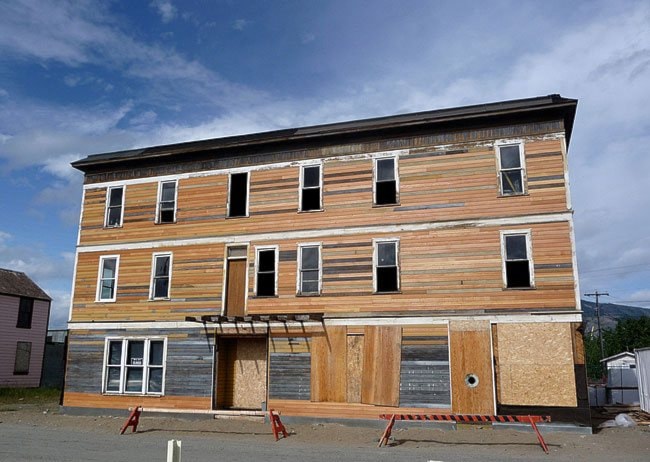By Teresa Earle
Special to the News
If anyone ever suggests that young people aren’t interested in their past, they should meet Lauren Blackburn and Matthias Bindig, this year’s winners of the Historic Places Initiative Conservation Project of the Year.
A geologist and relative newcomer to the Yukon, Blackburn first came to Keno City to stake claims for Alexco Resources in the summer of 2006. There she befriended Bindig, a prospector and Keno resident who took the time to share the area’s treasures and stories with her.
“It’s a super-cute little town, and right away I felt good about being there. Everyone was so welcoming,” says Blackburn. “On one of my last nights there, Matthias took me to Wernecke House on his ATV about eight kilometres from town.”
“He started telling me about this amazing man, Livingston Wernecke, as I’m standing in Wernecke’s house on the first mine site in Keno,” she recalls. “I can’t explain it, this feeling of É wow, this is it. The whole situation felt surreal - it was such a magical place, and at the same time, it was just very sad that this man had been forgotten.”
Blackburn isn’t the first visitor to fall under Keno’s spell. Once a booming city that served the second richest silver mining district in North America, today, Keno is more likely to be described as a living ghost town and home to artists, prospectors and other colourful characters who might number two dozen in a good year. Tourists don’t come in droves to Keno City, but those who venture to the end of the Silver Trail are enchanted by what they find.
The story of Livingston Wernecke, one of the region’s dominant historical figures, captivated Blackburn. She set out to research all she could about the mining engineer and long-time Keno Mine superintendent who was regarded as a Yukon exploration pioneer.
“Wernecke was the man, a hard-core guy,” says Blackburn. “He was an insanely determined, hardworking guy - really smart and business-savvy, and focused on infrastructure and making the locals happy.”
After much dreaming and deliberation, Blackburn and Bindig decided to restore Wernecke House. The process involved lots of research and report writing, fundraising, plenty of consultation and some red tape, but Blackburn is very positive about the experience. They worked closely with Yukon government historic sites staff and successfully applied to two heritage funding programs. They were able to obtain a letter of support from the claim holder, Alexco, and they raised more money for their first season than expected, including $1,000 from Keno residents alone.
“Last year we focused on preventing further deterioration,” says Blackburn. “We did brushing and clean-up around the site and removed glass and nails. We were really lucky because Keno locals have done so many restoration projects in the community that they know what they’re doing, so we didn’t need to bring in expensive contractors.”
By the time autumn set in, Bindig and Blackburn had put in hundreds of volunteer hours, the house was stabilized with new beams and posts, and it was clad to winter. This year they plan to complete the foundation, roof, front and back porches, and install new windows. Blackburn admits that life’s demands - like the rigours of her job and paying off student loans - may get in the way, but she also notes that they have received considerable support for their work on Wernecke House.
“This year I did a presentation at the Geoscience Forum about it. Perhaps it’s not your average geological talk, but it really is about mining - the historical significance of exploration in the Yukon,” she says. “We’re both involved in exploration. I think it’s really important to take this project all the way to set an example.”
Recognizing the need for people to go beyond the books and learn about history in real live settings, Blackburn dreams of a third season that would see Wernecke House turned into an interpreted historic attraction. Curious visitors would be able to read about Wernecke’s obsession with work, the dairy cow he kept behind the house and his loyalty to employees and their families. A prospector has already donated an antique wood stove and equipment for the house that originally came from the Mayo district.
“It’s not my project or Matthias’ project, it really is the Keno Community Club’s project - we’re just young and energetic,” says Blackburn. “But I really hope we can do what we set out to do, so that it stays a good news story and visitors can go up there and learn about it.”
For more information on Yukon’s historic places, please go to www.yukonhistoricplaces.ca.
This article is part of a series produced by the Yukon Department of Tourism and Culture with the support of the Government of Canada, Historic Places Initiative.
